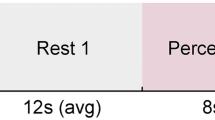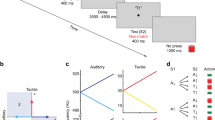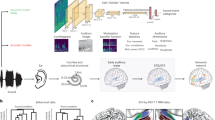Abstract
2Sound decoding is important for patients with sensory loss, such as the blind. Previous studies on sound categorization were conducted by estimating brain activity using univariate analysis or voxel-wise multivariate decoding methods and suggested some regions were sensitive to auditory categories. It is proposed that feedback connections between brain areas may facilitate auditory object selection. Therefore, it is important to explore whether functional connectivity among regions can be used to decode sound category. In this study, we constructed whole-brain functional connectivity patterns when subjects perceived four different sound categories and combined them with multivariate pattern classification analysis for sound decoding. The categorical discriminative networks and regions were determined based on the weight maps. Results showed that a high accuracy in multi-category classification was obtained based on the whole-brain functional connectivity patterns and the results were verified by different preprocessing parameters. Insight into the category discriminative functional networks showed that contributive connections crossed the left and right brain, and ranged from primary regions to high-level cognitive regions, which provide new evidence for the distributed representation of auditory object. Further analysis of brain regions in the discriminative networks showed that superior temporal gyrus and Heschl’s gyrus significantly contributed to discriminating sound categories. Together, the findings reveal that functional connectivity based multivariate classification method provides rich information for auditory category decoding. The successful decoding results implicate the interactive properties of the distributed brain areas in auditory sound representation.




Similar content being viewed by others
References
Arnott, S. R., Binns, M. A., Grady, C. L., & Alain, C. (2004). Assessing the auditory dual-pathway model in humans. Neuroimage, 22, 401–408.
Bethmann, A., & Brechmann, A. (2014). On the definition and interpretation of voice selective activation in the temporal cortex. Frontiers in Human Neuroscience, 8, 499.
Binder, J. R., Frost, J. A., Hammeke, T. A., Bellgowan, P. S. F., Springer, J. A., Kaufman, J. N., & Possing, E. T. (2000). Human temporal lobe activation by speech and nonspeech sounds. Cerebral Cortex, 10, 512–528.
Bizley, J. K., & Cohen, Y. E. (2013). The what, where and how of auditory-object perception. Nature Reviews. Neuroscience, 14, 693–707.
Bohland, J. W., Bokil, H., Allen, C. B., & Mitra, P. P. (2009). The brain atlas concordance problem: Quantitative comparison of anatomical Parcellations. PLoS One, 4, e7200.
Chang, C. C., & Lin, C. J. (2011). LIBSVM: A library for support vector machines. ACM Transactions on Intelligent Systems and Technology, 2, 27.
Doehrmann, O., Naumer, M. J., Volz, S., Kaiser, J., & Altmann, C. F. (2008). Probing category selectivity for environmental sounds in the human auditory brain. Neuropsychologia, 46, 2776–2786.
Engel, L. R., Frum, C., Puce, A., Walker, N. A., & Lewis, J. W. (2009). Different categories of living and non-living sound-sources activate distinct cortical networks. Neuroimage, 47, 1778–1791.
Filippi, M., & Rocca, M. A. (2016). Clinical applications of the functional connectome. Neuromethods, 119, 893–903.
Fox, M. D., Zhang, D. Y., Snyder, A. Z., & Raichle, M. E. (2009). The global signal and observed Anticorrelated resting state brain networks. Journal of Neurophysiology, 101, 3270–3283.
Friston, K. J., Frith, C. D., Liddle, P. F., & Frackowiak, R. S. J. (1993). Functional connectivity - the principal-component analysis of large (pet) data sets. Journal of Cerebral Blood Flow and Metabolism, 13, 5–14.
Giordano, B. L., McDonnell, J., & McAdams, S. (2010). Hearing living symbols and nonliving icons: Category specificities in the cognitive processing of environmental sounds. Brain and Cognition, 73, 7–19.
Gonzalez-Castillo, J., Hoy, C. W., Handwerker, D. A., Robinson, M. E., Buchanan, L. C., Saad, Z. S., & Bandettini, P. A. (2015). Tracking ongoing cognition in individuals using brief, whole-brain functional connectivity patterns. Proceedings of the National Academy of Sciences of the United States of America, 112, 8762–8767.
Husain, F. T., McKinney, C. M., & Horwitz, B. (2006). Frontal cortex functional connectivity changes during sound categorization. Neuroreport, 17, 617–621.
Kamitani, Y., & Tong, F. (2005). Decoding the visual and subjective contents of the human brain. Nature Neuroscience, 8, 679–685.
Klein, M. E., & Zatorre, R. J. (2015). Representations of invariant musical categories are decodable by pattern analysis of locally distributed BOLD responses in superior temporal and intraparietal sulci. Cerebral Cortex, 25, 1947–1957.
Lee, Y. S., Peelle, J. E., Kraemer, D., Lloyd, S., & Granger, R. (2015). Multivariate sensitivity to voice during auditory categorization. Journal of Neurophysiology, 114, 1819–1826.
Lewis, J. W., Wightman, F. L., Brefczynski, J. A., Phinney, R. E., Binder, J. R., & DeYoe, E. A. (2004). Human brain regions involved in recognizing environmental sounds. Cerebral Cortex, 14, 1008–1021.
Lewis, J. W., Brefczynski, J. A., Phinney, R. E., Janik, J. J., & DeYoe, E. A. (2005). Distinct cortical pathways for processing tool versus animal sounds. The Journal of Neuroscience, 25, 5148–5158.
Liljestrom, M., Stevenson, C., Kujala, J., & Salmelin, R. (2015). Task- and stimulus-related cortical networks in language production: Exploring similarity of MEG- and fMRI-derived functional connectivity. Neuroimage, 120, 75–87.
Murphy, K., & Fox, M. D. (2017). Towards a consensus regarding global signal regression for resting state functional connectivity MRI. Neuroimage, 154, 169–173.
Naselaris, T., Kay, K. N., Nishimoto, S., & Gallant, J. L. (2011). Encoding and decoding in fMRI. Neuroimage, 56, 400–410.
Norman, K. A., Polyn, S. M., Detre, G. J., & Haxby, J. V. (2006). Beyond mind-reading: Multi-voxel pattern analysis of fMRI data. Trends in Cognitive Sciences, 10, 424–430.
Nourski, K. V., Steinschneider, M., Rhone, A. E., & Howard, M. A. (2017). Intracranial electrophysiology of auditory selective attention associated with speech classification tasks. Frontiers in Human Neuroscience, 10, 691.
Parente, F., Frascarelli, M., Mirigliani, A., Di Fabio, F., Biondi, M., & Colosimo, A. (2018). Negative functional brain networks. Brain Imaging and Behavior, 12, 467–476.
Sharda, M., & Singh, N. C. (2012). Auditory perception of natural sound categories - an Fmri study. Neuroscience, 214, 49–58.
Smith, J., Morgan, J. R., Zottoli, S. J., Smith, P. J., Buxbaum, J. D., & Bloom, O. E. (2011). Regeneration in the era of functional genomics and gene network analysis. The Biological Bulletin, 221, 18–34.
Staeren, N., Renvall, H., De Martino, F., Goebel, R., & Formisano, E. (2009). Sound categories are represented as distributed patterns in the human auditory cortex. Current Biology, 19, 498–502.
Vetter, P., Smith, F. W., & Muckli, L. (2014). Decoding sound and imagery content in early visual cortex. Current Biology, 24, 1256–1262.
Wang, X., Fang, Y., Cui, Z., Xu, Y., He, Y., Guo, Q., & Bi, Y. (2016). Representing object categories by connections: Evidence from a Mutivariate connectivity pattern classification approach. Human Brain Mapping, 37, 3685–3697.
Wang, H., Zhang, G., & Liu, B. (2017). Influence of auditory spatial attention on cross-modal semantic priming effect: Evidence from N400 effect. Experimental Brain Research, 235, 331–339.
Whitfield-Gabrieli, S., & Nieto-Castanon, A. (2012). Conn: A functional connectivity toolbox for correlated and anticorrelated brain networks. Brain Connectivity, 2, 125–141.
Wightman, F. L., & Kistler, D. J. (1989). Headphone simulation of free-field listening .1. Stimulus synthesis. The Journal of the Acoustical Society of America, 85, 858–867.
Zhang, F. Q., Wang, J. P., Kim, J., Parrish, T., & Wong, P. C. M. (2015). Decoding multiple sound categories in the human temporal cortex using high resolution fMRI. PLoS One, 10.
Zhang, G. Y., Cheng, Y., & Liu, B. L. (2017a). Abnormalities of voxel-based whole-brain functional connectivity patterns predict the progression of hepatic encephalopathy. Brain Imaging and Behavior, 11, 784–796.
Zhang, Z. Y., Zhang, G. Y., Zhang, Y. Y., Liu, H., Xu, J. H., & Liu, B. L. (2017b). Cross-modal integration of polyphonic characters in Chinese audio-visual sentences: A MVPA study based on functional connectivity. Experimental Brain Research, 235, 3743–3755.
Funding
This work was supported by the National Natural Science Foundation of China (No. U1736219, No. 61571327 and No. 61503278) and Peiyang Scholar Program of Tianjin University (No. 2018XRG-0037).
Author information
Authors and Affiliations
Corresponding author
Ethics declarations
Conflict of interest
Jinliang Zhang, Gaoyan Zhang, Xianglin Li, Peiyuan Wang, Bin Wang, and Baolin Liu declare that they have no actual or potential conflict of interest including any financial, personal or other relationships with other people or organizations that can inappropriately influence our work. All of the authors declare that the work described in the manuscript was original research that has not been published previously, and was not under consideration for publication elsewhere.
Ethical approval
This study was approved by the Research Ethics Committee of Tianjin University. All procedures followed were in accordance with the ethical standards of the responsible committee on human experimentation (institutional and national) and with the Helsinki Declaration of 1975, and the applicable revisions at the time of the investigation.
Informed consent
Informed consent was obtained from all subjects for being included in the study.
Rights and permissions
About this article
Cite this article
Zhang, J., Zhang, G., Li, X. et al. Decoding sound categories based on whole-brain functional connectivity patterns. Brain Imaging and Behavior 14, 100–109 (2020). https://doi.org/10.1007/s11682-018-9976-z
Published:
Issue Date:
DOI: https://doi.org/10.1007/s11682-018-9976-z




